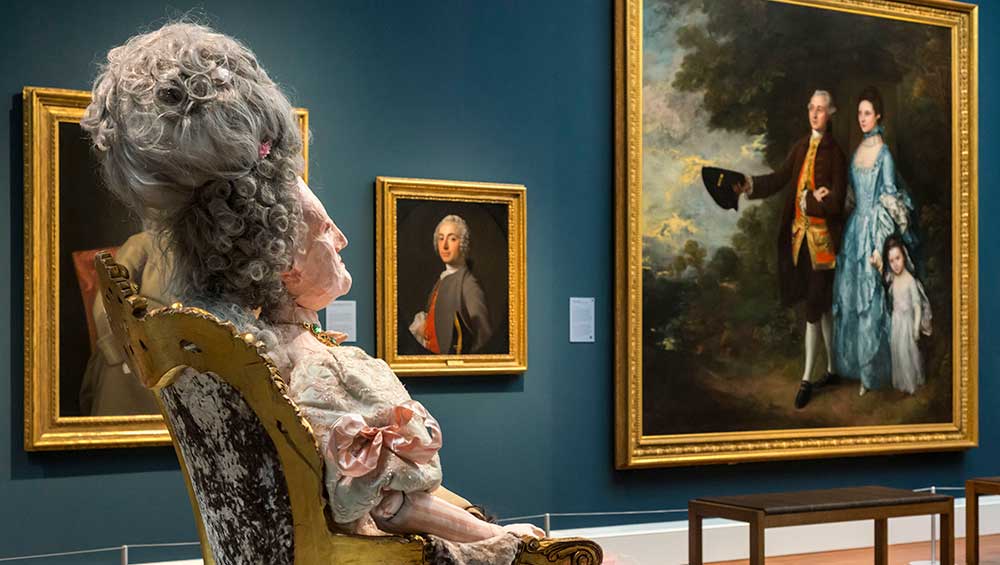
Uncanny Visions: Paula Rego and Francisco de Goya at the Holburne Museum, Bath. Photo: Jo Hounsome.
The Holburne Museum, Bath
27 September 2024 – 5 January 2025
by BETH WILLIAMSON
Francisco de Goya y Lucientes (1746-1828) and Paula Rego (1935-2022) may have lived and worked two centuries apart, but their fascination with popular stories and folklore in their work means that both artists delved into an underlying darkness in their subjects, creating images that unsettle the viewer. For Goya, it was the farce of social rules and expectations that inspired him to create prints such as the series Los Disparates (The Follies) (1815-23), featured in this exhibition. For Rego, meanwhile, it was the cruelty often found in children’s verse that sparked her series Nursery Rhymes, shown in full here – more than 30 etchings and aquatints made in 1989, plus five additional prints made in 1994.
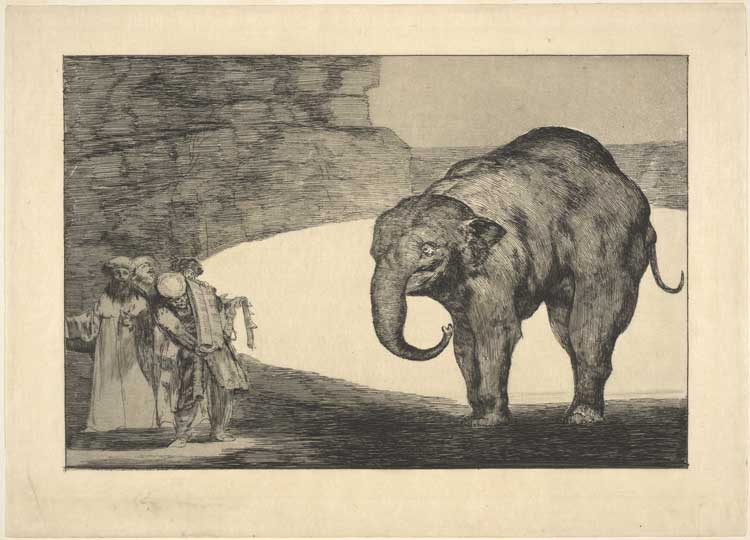
Francisco de Goya, Quien se pondrá el cas - cabel al gato, Disparate de bestia, Los Proverbios, print. © The Trustees of the British Museum.
Rego’s admiration for Goya was such that she slept with seven of his prints hanging in her bedroom. She first encountered his work as a child visiting the Museo Nacional del Prado, Madrid. It was the beginning of fascination that lasted a lifetime, in her artistic work and in her life. Three of Goya’s prints she lived with belonged to The Caprices (Los Caprichos, 1797-99) and four belonged to Disasters of War (Los Desastres de la Guerra, 1810-15/20). In both cases, she selected highly emotional images that put grief and violence (often against women) at their core. These seven prints are grouped together in a tiny gallery space at The Holburne, accompanied by some examples of Rego’s work, including one uncanny three-dimensional soft studio prop (this one a girl with doll and armchair), occupying a corner of the space with an air of malevolence that gets beneath the skin. The combination of images is decidedly disconcerting and one wonders how Rego slept at night.
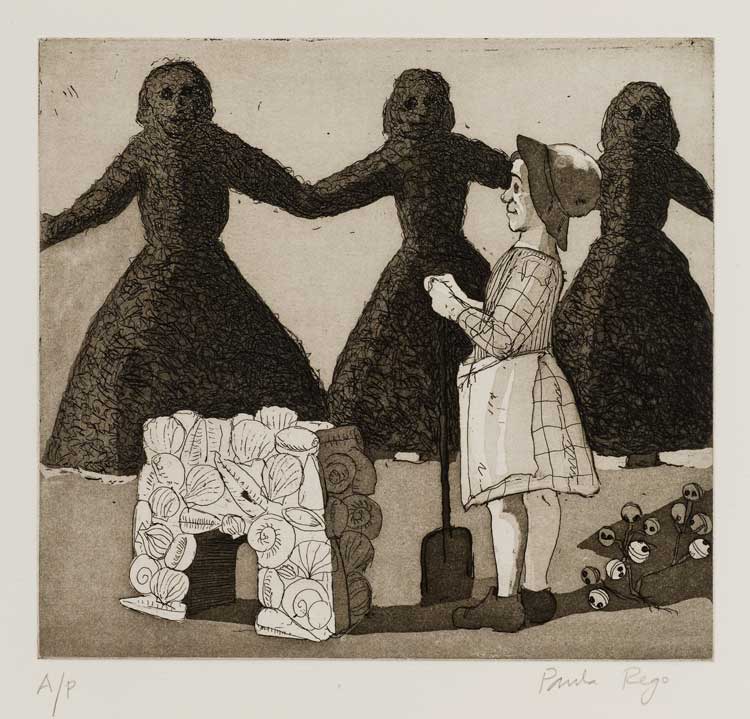
Paula Rego. Mary Mary Quite Contrary II, 1989. Etching and aquatint. © Paula Rego. All rights reserved 2024 / Bridgeman Archives.
Individual works from Goya’s Follies and Rego’s Nursery Rhymes are beautifully matched in this exhibition, usually in pairs. Whether put together based on thematic similarities, or on visual resonance, there are wonders to be seen here. We know that Rego admired Goya’s work, but somehow it is still surprising, even shocking, to see their work in such close proximity, each enhancing the richness and experience of the other.
Rego began printmaking with the assistance of printmaker Paul Coldwell in 1987. It soon became a powerful medium for the artist to explore creative and imaginative expression through storytelling. More than that, it also became a way of working through her own inner darkness, processing difficult emotions sprung forth by the illness and death of her husband, Victor Willing, in 1988. By the time she made the Nursery Rhyme series in 1989, Rego had perhaps already faced some her darkest demons and was equipped to face Goya’s Follies head on.
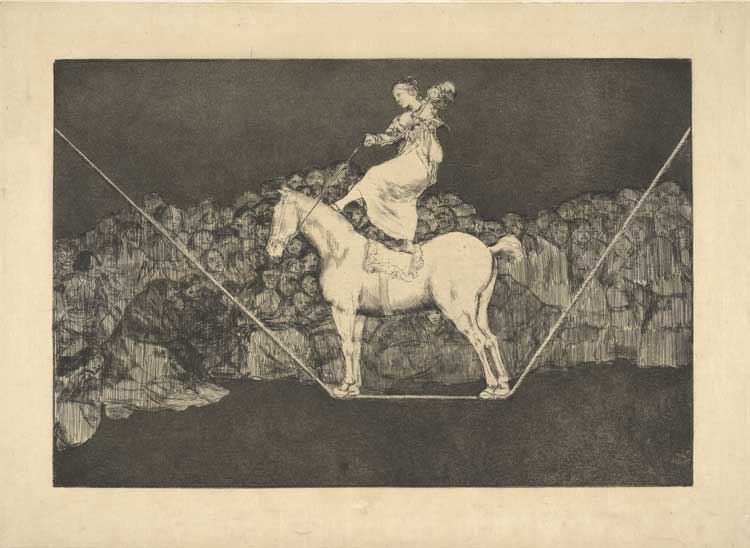
Francisco de Goya, Bailando en una cuerda floja, Disparate punctual, Los Proverbios, print. © The Trustees of the British Museum.
The Follies were published posthumously in Madrid in 1864 as a series of 18 prints with four more found in Paris in 1877. They are enigmatic, inviting multiple interpretations or readings, although Goya’s stance against the political and religious orthodoxy of his day is key, as are his wider reflections on human nature. As Rego once explained: “Not just for me, but for everybody he was so amazing. Goya drew all the terrible things that people do to each other and the Black Paintings are wonderful … he was present all the time in my mind.”
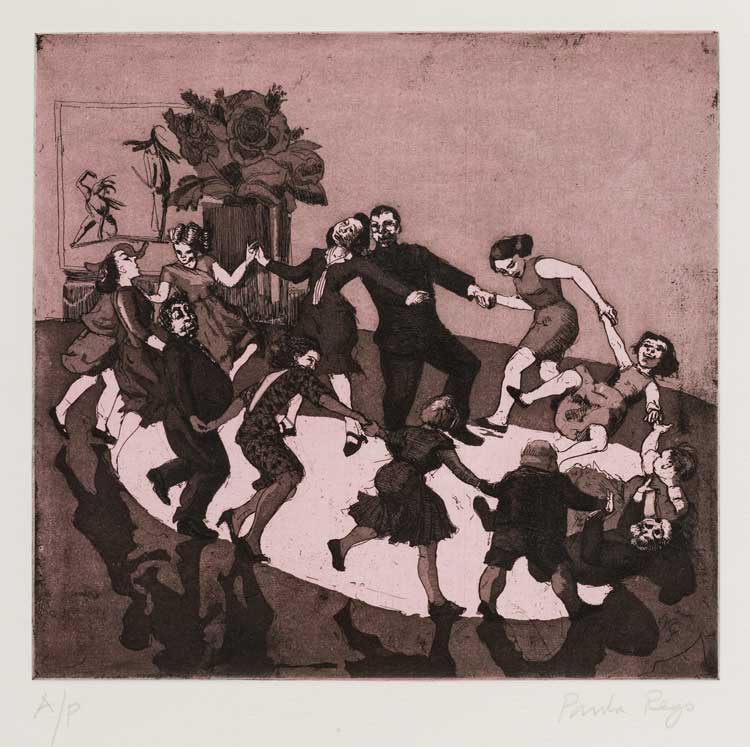
Paula Rego. Ring-a-ring o’roses, 1989. Etching and aquatint on paper. © Paula Rego. All rights reserved 2024 / Bridgeman Archives.
This meeting of minds across time and space is voiced here by Rego and evident in every aspect of this exhibition as the Follies and the Nursery Rhymes reverberate with menace around the room. It is the notion of the uncanny that underlines the work of both artists. The scenes depicted may be unsettling, but they are oddly familiar. Childhood fears and fantasies seem to come to life before our eyes. Perhaps the most astonishing pairing is that of Goya’s Merry folly, Plate 12 from The Follies (showing three elegant young women and three grotesque men, all with outstretched arms and legs), with Rego’s well-known Ring-a-ring o’Roses (1989). Therefore, while she acknowledged the importance of Goya’s The Caprices for her making of the Nursery Rhymes, this particular pairing shows evidence of her wider knowledge of Goya and richer understanding of his work.
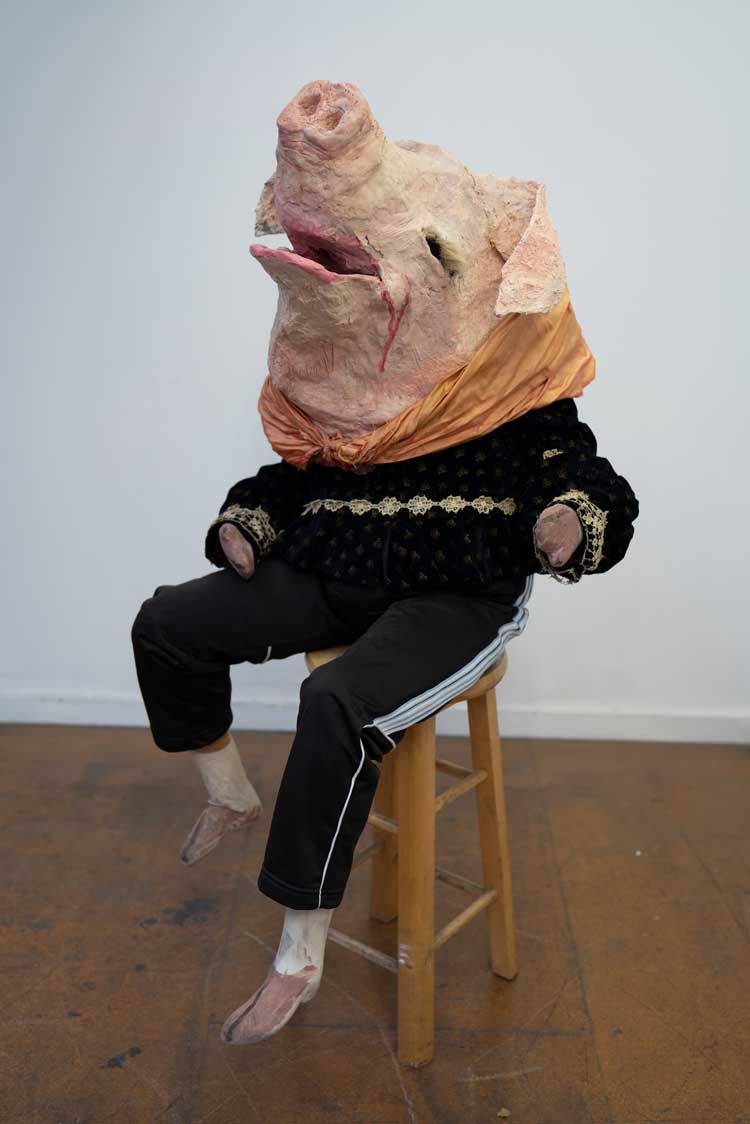
Paula Rego. Prince Pig, 2005-06. Papier mache and fabric. © Paula Rego. All rights reserved 2024 / Bridgeman Archives.
Rego’s studio prop Prince Pig (2005-06) has a boy’s body with a pig’s head. It also plays to an interest in anthropomorphism and animalisation, an absurdity that is somehow also tender. The humanisation of animals has been a common trope in art since antiquity and one that Goya deployed too. From the 1980s, Rego introduced the use of animal and human figures in her works saying: “Sometimes, animals are better characters to play the roles. They are less sentimental.”
.jpg)
Paula Rego. Pride, 2019, Holburne Museum. Photo: Jo Hounsome.
For me, Rego’s figure of Pride (2019) steals the show, placed, as it is, in the midst of the Holburne’s 18th-century portraits. Pride is one of an unfinished series of the Seven Deadly Sins made by Rego. The figure of Pride is presented in the guise of the French queen Marie Antoinette who was guillotined in 1793. She was also a contemporary of many of the sitters shown in the surrounding portraits, such as Alicia and Jane Clarke (c1758) by Arthur Devis, or the women at the centre of Johan Zoffany’s The Auriol and Dashwood Families, c1783-87.
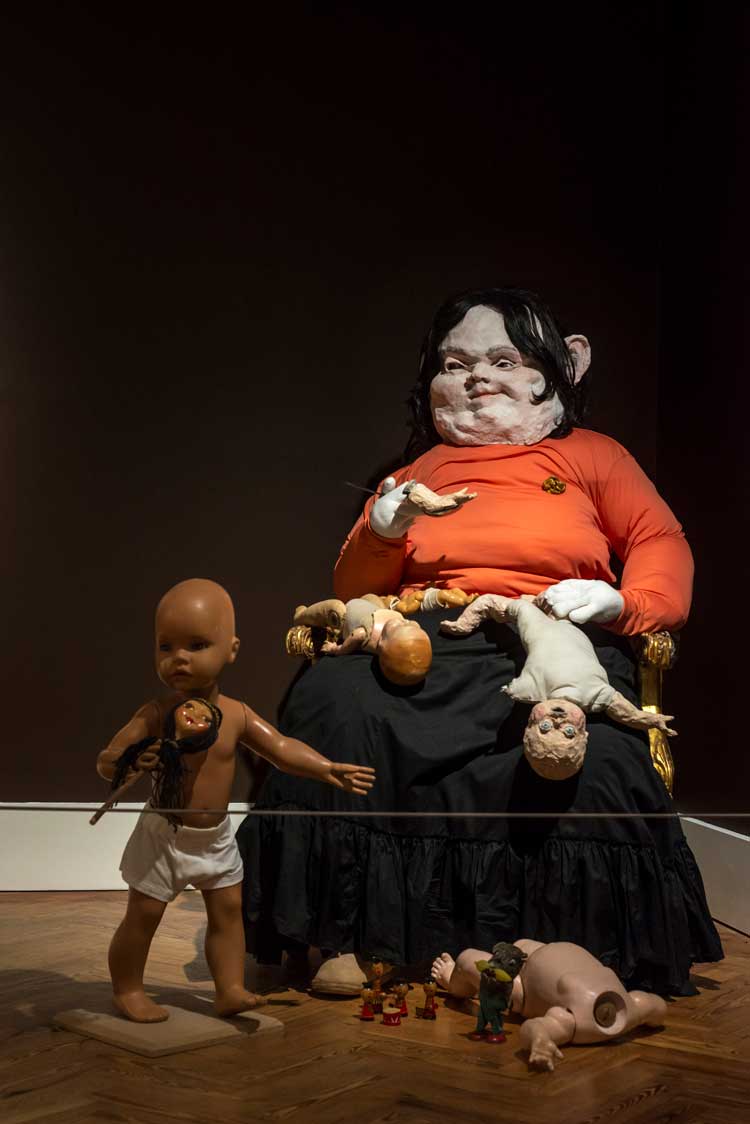
Paula Rego, Gluttony, 2019 at the Holburne Museum. Photo: Jo Hounsome.
The figure of Gluttony (2019) comes a very close second to Pride. It is shown as a cannibalistic child-eating woman that recalls the fairytale character of the witch in Hansel and Gretel, and evokes Goya’s Saturn Devouring His Son (1820-23), one of his best-known Black Paintings. For Rego’s part, she identified with gluttony more than any other sin. Remembering how she ate everyone’s leftover puddings at finishing school and, hence, gained so much weight as to be unrecognisable, it is perhaps Rego’s inner demons that play out more than anything. Time after time in this exhibition, Goya and Rego shock, unsettle and disconcert, and yet they delight and amuse at the same time. With surprises at every turn, it is an exhibition that horrifies and thrills – and the longer time you spend there, the more there is to discover.
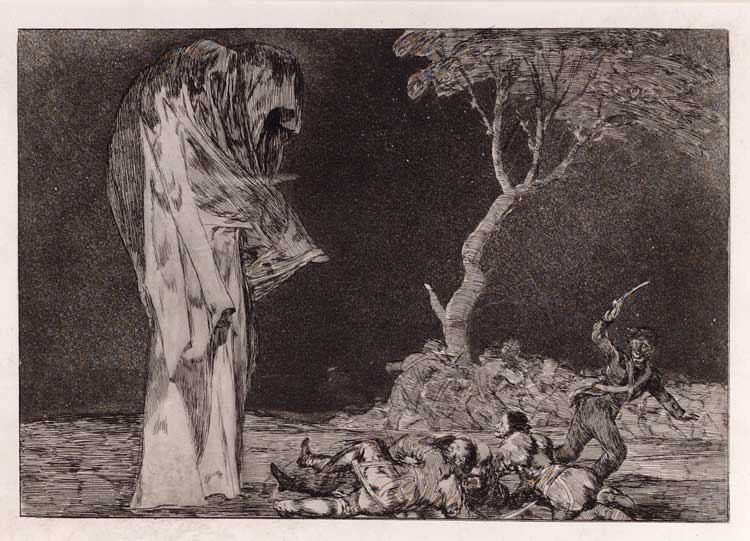
Francisco de Goya, Folly of Fear. © The Higgins Bedford.